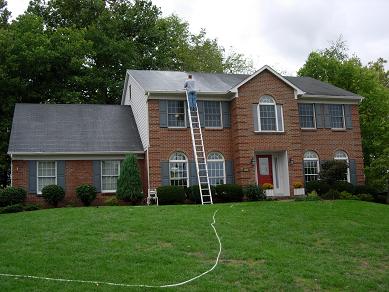In my last post I detailed why I feel that certain roof cleaning chemicals are a superior alternative to roof power washing. There are many roof cleaning products and solutions on the market these days, all claiming to be superior, and all claiming that their’s is the safest and most effective, but it’s important to keep in mind that these are companies that are just trying to make a buck and will say just about anything to sell their product.
In my considerable experience, there’s only one way to clean a roof the right way, and that’s with a sodium hypochlorite-based solution. Sodium hypochlorite is the active ingredient in bleach and chlorine, and when applied to a roof at the right ratios is quite simply the safest, most effective way to clean a roof. It is the recommended method for cleaning roofs by ARMA (the Asphalt Roofing Manufacturers Association), and their technical bulletin on the topic can be viewed here (pdf file).
 ARMA recommends a mixture of bleach, water, and TSP (which can be found in paint stores), but be careful with the TSP on painted surfaces as it can remove the gloss in high dosages. I have found that the TSP is helpful but not necessary, as the bleach is the primary cleaning agent. In addition, every roof cleaning professional that uses this method has his or her own “secret” additives that they add to this mix to give it just the right cleaning potency for their climate, but the common denominator is a final liquid solution that is about 3-4% sodium hypochlorite. So if your common household bleach is around 6%, you would need to have equal parts bleach and water to get you down to 3%.
ARMA recommends a mixture of bleach, water, and TSP (which can be found in paint stores), but be careful with the TSP on painted surfaces as it can remove the gloss in high dosages. I have found that the TSP is helpful but not necessary, as the bleach is the primary cleaning agent. In addition, every roof cleaning professional that uses this method has his or her own “secret” additives that they add to this mix to give it just the right cleaning potency for their climate, but the common denominator is a final liquid solution that is about 3-4% sodium hypochlorite. So if your common household bleach is around 6%, you would need to have equal parts bleach and water to get you down to 3%.
This is by far the safest and most effective way to clean a roof, but the catch is that an average one-story ranch house is going to require anywhere from 30 to 60 gallons of total mix. That means you’d need about 15-30 gallons of typical 6% household bleach. Typically, the pros will have the whole mix in a large poly tank on their truck or trailer, and will use a battery-powered pump to deliver the solution through a long polybraided hose up to the roof surface. They’ll usually have a bleach resistant tip on the end of the hose that evenly disperses a soft spray over the roof surface. They’ll leave the solution on the surface to let it do its thing for several minutes before rinsing the surface with water from the garden hose. So no power washers or scrubbing should be required (the only exception could be for thick moss accumulations). If you’re doing this yourself, you’d also want to keep the whole perimeter of the home rinsed down very well during the application (preferably by a second person) as sodium hypochlorite can have a negative effect on landscaping if not properly diluted. Be especially mindful of areas where downspouts empty into grass or other greenery. Occasionally you might have to go over a few spots a second time, but the results should be instant! Rinse the roof and perimeter very well, let dry, and enjoy your new-looking roof.
You can do this yourself, of course, but you’d be looking at having to purchase hundreds of dollars worth of equipment and chemicals, so why not just hire a professional that specializes in no-pressure roof cleaning? Try to find one that utilizes the roof cleaning chemicals that I just outlined.
If you do decide to go for it yourself, BE CAREFUL. The hazards include, but are not limited to: falling off ladders, slipping on the roof surface (which is made very slick when solution is applied), getting bleach spray in your eyes or lungs (wear eye protection and a mask), leaning a ladder against a power line, etc. This work is not for the faint of heart. Harnesses and support systems might be a good idea.
You can expect this type of treatment to keep the roof clean anywhere from two to six years before stains start to return, with an average of three to four years. I’ve yet to come across any so-called “sealers” that actually work. Your best bet is just to have the roof re-cleaned by a professional when the algae streaks have returned. The zinc strips that some try to market don’t work that well in my opinion. They may be somewhat effective for the 2-3 feet of roof surface directly below the strip, but what about the rest of the roof? The zinc is also a very expensive material. Just have a pro clean your roof every couple years and save yourself the hassle. If you need guidance on how to find a good contractor then read this post about roof cleaners.

 ARMA recommends a mixture of bleach, water, and TSP (which can be found in paint stores), but be careful with the TSP on painted surfaces as it can remove the gloss in high dosages. I have found that the TSP is helpful but not necessary, as the bleach is the primary cleaning agent. In addition, every roof cleaning professional that uses this method has his or her own “secret” additives that they add to this mix to give it just the right cleaning potency for their climate, but the common denominator is a final liquid solution that is about 3-4% sodium hypochlorite. So if your common household bleach is around 6%, you would need to have equal parts bleach and water to get you down to 3%.
ARMA recommends a mixture of bleach, water, and TSP (which can be found in paint stores), but be careful with the TSP on painted surfaces as it can remove the gloss in high dosages. I have found that the TSP is helpful but not necessary, as the bleach is the primary cleaning agent. In addition, every roof cleaning professional that uses this method has his or her own “secret” additives that they add to this mix to give it just the right cleaning potency for their climate, but the common denominator is a final liquid solution that is about 3-4% sodium hypochlorite. So if your common household bleach is around 6%, you would need to have equal parts bleach and water to get you down to 3%.